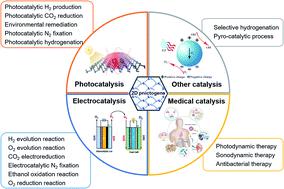当前位置:
X-MOL 学术
›
J. Mater. Chem. A
›
论文详情
Our official English website, www.x-mol.net, welcomes your
feedback! (Note: you will need to create a separate account there.)
Emerging 2D pnictogens for catalytic applications: status and challenges
Journal of Materials Chemistry A ( IF 10.7 ) Pub Date : 2020-06-05 , DOI: 10.1039/d0ta04068a Xiang Yu 1, 2, 3, 4, 5 , Weiyuan Liang 1, 2, 3, 4, 5 , Chenyang Xing 1, 2, 3, 4, 5 , Keqiang Chen 1, 2, 3, 4, 5 , Jianming Chen 1, 2, 3, 4, 5 , Weichun Huang 6, 7, 8, 9, 10 , Ni Xie 1, 2, 3, 4, 5 , Meng Qiu 10, 11, 12, 13 , Xiaobing Yan 14, 15, 16, 17, 18 , Zhongjian Xie 1, 2, 3, 4, 5 , Han Zhang 1, 2, 3, 4, 5
Journal of Materials Chemistry A ( IF 10.7 ) Pub Date : 2020-06-05 , DOI: 10.1039/d0ta04068a Xiang Yu 1, 2, 3, 4, 5 , Weiyuan Liang 1, 2, 3, 4, 5 , Chenyang Xing 1, 2, 3, 4, 5 , Keqiang Chen 1, 2, 3, 4, 5 , Jianming Chen 1, 2, 3, 4, 5 , Weichun Huang 6, 7, 8, 9, 10 , Ni Xie 1, 2, 3, 4, 5 , Meng Qiu 10, 11, 12, 13 , Xiaobing Yan 14, 15, 16, 17, 18 , Zhongjian Xie 1, 2, 3, 4, 5 , Han Zhang 1, 2, 3, 4, 5
Affiliation

|
The exfoliation of phosphorene from black phosphorus to afford mono-elemental two-dimensional (2D) materials (Xenes) has caused a boom in various fields since 2014. Among the Xenes, an emerging class of material, 2D pnictogens, which includes phosphorene, arsenene, antimonene, and bismuthene, has drawn a great deal of attention in the field of catalysis owing to their high specific surface area, mechanical properties, biocompatibility, and optical and electrical performance. With the development of interdisciplinary research, it has become a new trend of scientific research, especially the application of catalysis in medicine, to break the barriers between disciplines and achieve multidisciplinary joint investigation. Herein, firstly, the structures, general properties, and synthetic methods of 2D pnictogen (group VA) materials are reviewed. Then, we summarize the various state-of-the-art catalytic applications of the 2D pnictogen family, such as photocatalysis, electrocatalysis, and medical catalysis, especially in terms of strategies to improve their catalytic performance, such as doping, functionalization, and heterostructures. We also shed some light on the cross-subject of photocatalytic and electrocatalytic processes for biomedical applications. Finally, we summarize the research progress, outlooks, and challenges for these 2D catalysts in terms of their catalytic performance, characterization, reaction mechanisms, exploration of new systems, and commercial applications. This review aims to highlight the catalytic effects of 2D pnictogen materials in enhancing the performance of reactions.
中文翻译:

用于催化应用的新兴二维光子学:现状和挑战
自2014年以来,磷从黑磷中剥落以提供单元素二维(2D)材料(Xenes)引起了各领域的繁荣。在Xenes中,新兴的一类材料是2D光电原,其中包括磷,砷由于其高的比表面积,机械性能,生物相容性以及光学和电学性能,锑,锑和铋在催化领域引起了极大的关注。随着跨学科研究的发展,打破学科间壁垒,实现多学科联合研究已成为科学研究的新趋势,尤其是催化在医学中的应用。在此,首先,对二维光致原(VA组)材料的结构,一般性质和合成方法进行了综述。然后,我们总结了2D光电原家族的各种最先进的催化应用,例如光催化,电催化和医学催化,尤其是在改善其催化性能的策略(例如掺杂,功能化和异质结构)方面。我们还阐明了生物医学应用中光催化和电催化过程的交叉主题。最后,我们就这些2D催化剂的催化性能,表征,反应机理,新系统的探索和商业应用总结了研究进展,前景和挑战。这篇综述的目的是强调2D光子学物质在增强反应性能方面的催化作用。例如光催化,电催化和医学催化,尤其是在改善其催化性能的策略(例如掺杂,功能化和异质结构)方面。我们还阐明了生物医学应用中光催化和电催化过程的交叉主题。最后,我们从这些2D催化剂的催化性能,表征,反应机理,新系统的探索和商业应用的角度总结了这些2D催化剂的研究进展,前景和挑战。这篇综述的目的是强调2D光子学物质在增强反应性能方面的催化作用。例如光催化,电催化和医学催化,尤其是在改善其催化性能的策略(例如掺杂,功能化和异质结构)方面。我们还阐明了生物医学应用中光催化和电催化过程的交叉主题。最后,我们从这些2D催化剂的催化性能,表征,反应机理,新系统的探索和商业应用的角度总结了这些2D催化剂的研究进展,前景和挑战。这篇综述的目的是强调2D光子学物质在增强反应性能方面的催化作用。和异质结构。我们还阐明了生物医学应用中光催化和电催化过程的交叉主题。最后,我们从这些2D催化剂的催化性能,表征,反应机理,新系统的探索和商业应用的角度总结了这些2D催化剂的研究进展,前景和挑战。这篇综述的目的是强调2D光子学物质在增强反应性能方面的催化作用。和异质结构。我们还阐明了生物医学应用中光催化和电催化过程的交叉主题。最后,我们从这些2D催化剂的催化性能,表征,反应机理,新系统的探索和商业应用的角度总结了这些2D催化剂的研究进展,前景和挑战。这篇综述的目的是强调2D光子学物质在增强反应性能方面的催化作用。
更新日期:2020-07-07
中文翻译:

用于催化应用的新兴二维光子学:现状和挑战
自2014年以来,磷从黑磷中剥落以提供单元素二维(2D)材料(Xenes)引起了各领域的繁荣。在Xenes中,新兴的一类材料是2D光电原,其中包括磷,砷由于其高的比表面积,机械性能,生物相容性以及光学和电学性能,锑,锑和铋在催化领域引起了极大的关注。随着跨学科研究的发展,打破学科间壁垒,实现多学科联合研究已成为科学研究的新趋势,尤其是催化在医学中的应用。在此,首先,对二维光致原(VA组)材料的结构,一般性质和合成方法进行了综述。然后,我们总结了2D光电原家族的各种最先进的催化应用,例如光催化,电催化和医学催化,尤其是在改善其催化性能的策略(例如掺杂,功能化和异质结构)方面。我们还阐明了生物医学应用中光催化和电催化过程的交叉主题。最后,我们就这些2D催化剂的催化性能,表征,反应机理,新系统的探索和商业应用总结了研究进展,前景和挑战。这篇综述的目的是强调2D光子学物质在增强反应性能方面的催化作用。例如光催化,电催化和医学催化,尤其是在改善其催化性能的策略(例如掺杂,功能化和异质结构)方面。我们还阐明了生物医学应用中光催化和电催化过程的交叉主题。最后,我们从这些2D催化剂的催化性能,表征,反应机理,新系统的探索和商业应用的角度总结了这些2D催化剂的研究进展,前景和挑战。这篇综述的目的是强调2D光子学物质在增强反应性能方面的催化作用。例如光催化,电催化和医学催化,尤其是在改善其催化性能的策略(例如掺杂,功能化和异质结构)方面。我们还阐明了生物医学应用中光催化和电催化过程的交叉主题。最后,我们从这些2D催化剂的催化性能,表征,反应机理,新系统的探索和商业应用的角度总结了这些2D催化剂的研究进展,前景和挑战。这篇综述的目的是强调2D光子学物质在增强反应性能方面的催化作用。和异质结构。我们还阐明了生物医学应用中光催化和电催化过程的交叉主题。最后,我们从这些2D催化剂的催化性能,表征,反应机理,新系统的探索和商业应用的角度总结了这些2D催化剂的研究进展,前景和挑战。这篇综述的目的是强调2D光子学物质在增强反应性能方面的催化作用。和异质结构。我们还阐明了生物医学应用中光催化和电催化过程的交叉主题。最后,我们从这些2D催化剂的催化性能,表征,反应机理,新系统的探索和商业应用的角度总结了这些2D催化剂的研究进展,前景和挑战。这篇综述的目的是强调2D光子学物质在增强反应性能方面的催化作用。











































 京公网安备 11010802027423号
京公网安备 11010802027423号